A Month with a Mac: A Die-Hard PC User's Perspective
by Anand Lal Shimpi on October 8, 2004 12:05 AM EST- Posted in
- Mac
Perfect Multi-tasking
So far, I've described OS X's multi-tasking as very similar to what is currently available under Windows, but where OS X sets itself apart is in a little feature called Exposé (note that typing an accented "e" is extremely easy under OS X - ALT-e followed by the "e" key or any vowel will do just that).By default, Exposé is activated by one of three function keys - F9, F10 or F11. Each function key serves a different purpose, each of which is a feature of Exposé. The theory behind Exposé is simple: it is a way of getting to a specific window on your desktop as fast as possible.
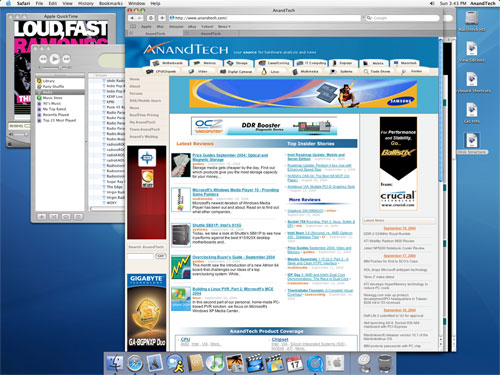
We start with our cluttered desktop...
Click to enlarge.
Hitting F9, for example, will cause Exposé to zoom out all of your active visible (unhidden) windows and essentially, tile them across your desktop. Then, using either the keyboard or the mouse, you can select the window that you want and everything goes back to normal, with the window that you have selected appearing in the foreground. The rest of the windows are untouched and are all in their original positions. The window that you selected is also in its original position; it is simply moved to the front so that you can see it.
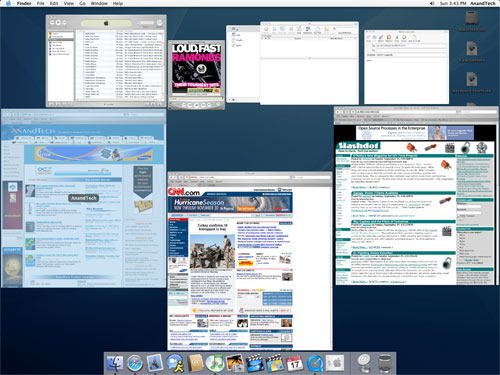
Hitting F9 activates Exposé across all applications.
Click to enlarge.
If you don't want to Exposé all windows, you can just Exposé the windows within a particular application (F10 by default), which is extremely handy for dealing with tons of images in Photoshop for example.
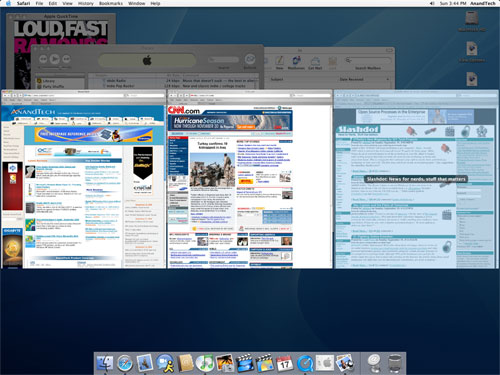
Hitting F10 activates Exposé across only a single application's windows.
Click to enlarge.
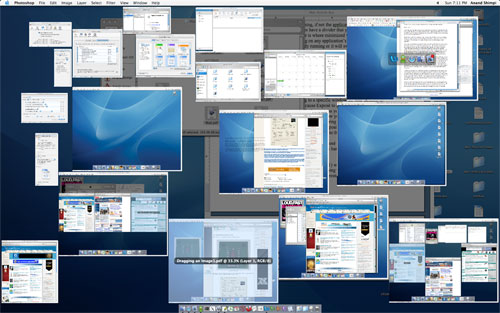
Another example of Exposé's usefulness in editing all of the images for this article in Photoshop.
Click to enlarge.
The final Exposé function lets you view your desktop (F11), which, to me, was like a more polished version of Windows-D, since after I was done doing whatever it is I needed to do on the desktop, Exposé deactivated and my screen was restored to its original state.
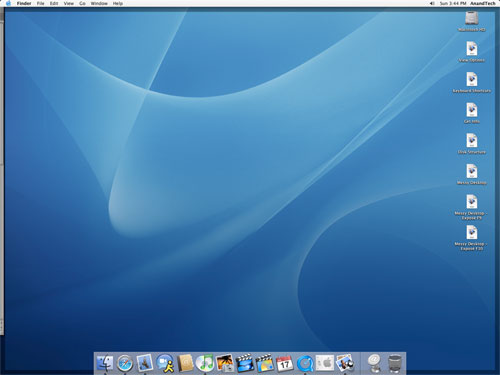
Hitting F11 reveals the desktop.
Click to enlarge.
The beauty of Exposé is difficult to convey in text alone. Honestly, the best way to evaluate it and understand its potential is to use it - luckily, there are Apple stores for this very purpose. Keep in mind that Exposé is very customizable as well and the three function keys that I mentioned above, although the defaults, are not the only ways that you can configure OS X to activate Exposé.
The benefits of Exposé are numerous. If you ever feel overwhelmed by having too many windows open, Exposé definitely alleviates that feeling as you don't have to tab through multiple applications to finally get to the window that you want. While Exposé does make having only a single display better, heavy multi-taskers will still enjoy the benefits of a dual display setup.
Since the OS X desktop environment is completely OpenGL accelerated, the performance of features like Exposé are not CPU limited - instead, they are GPU limited. Luckily, using Exposé with many windows open is not very stressful on even a Radeon 9600, but you do run out of video memory very quickly - in which case, your system ends up swapping to main memory over the AGP bus, making the Exposé animation considerably choppy. It seems that the sweet spot for more than a handful of windows open is around 128MB of video memory, with 256MB being perfect - needless to say, I found the mere 64MB that came on the Radeon 9600 which shipped with the system to be too little. There is no detriment to functionality if you don't have enough video memory; the Exposé animation simply becomes more choppy (which can be annoying on a $3000 system).










215 Comments
View All Comments
jecastej - Friday, October 8, 2004 - link
Sorry, they updated the review with G5 2.5, dual Xeon and dual opteron. New path:http://www.barefeats.com/pentium4.html
CindyRodriguez - Friday, October 8, 2004 - link
I'm not looking for Anand to praise the Mac, I'm looking for a good article and sorry, i'm not seeing it. If Anand lauded praise on the Mac and got all the details about the machine and the OS wrong, I'd be complaining about that too.This is an experience piece, but as I said, I'd have appreciated it much more if would wrote it as a newbie then actually learned about it to comment out the junk.
#27 Your explanation for why Apple is "forced" to make dual machines is laughable. It's merely a matter of MHz? The PPC 970 is shipping at 2.5 GHz while the Athlon64/Opteron is shipping at 2.4 GHz. AMD has Apple/ibm beat on memory performance but a 970 can perform more operations per clock than a *hammer core. They are both good chips.
Not only that, Apple initally released the line with two single processor models and one dual, then they moved to two duals, then they moved all dual as they speed bumped 25%.
The reality is more along the lines of.. the machine is designed for dual cpus so the cost of nearly doubling performance is minimal compared to a PC where you need a lower volume dual board with a potentially different chipset and dual ram banks for opterons.
#22 You brought up an excellent point. With the release of 10.3, the official gcc tree had NO optimizations for the PPC 970. The IBM Design lead for the 970 told arstechnica that they modified gcc to optomize the G5 a bit like a Power4 and a bit like a G4 because it shared characteristics of both chips, but it was more different than just the amalgam of them.
Current OS X software is horribly under-optomized for the G5. Our researchers have been using IBMs xlc and xlf compilers with real PPC 970 and G5 support and his code is way faster than gcc code. Initially they were seeing an average speed up of 30-40 percent but he recently told us that some code is running twice as fast.
cosmotic - Friday, October 8, 2004 - link
You didn't compare things like ... benchmarks to the speed of a PC... Granted the Mac *feals* sluggish, look at benchmarks and real-world preeformance of things like PS Filters, rendering, etc.http://www.barefeats.com/pentium4.html
Also, your forgetting that Mac's come with Firewire 800, optical audio in/out, etc. PC Workstatioins don't come with this.
As for OS Sluggishness, Many times Apple traded performance for smoothness. How often do you resize a window or minimize or whatever and theres a redraw issue on a PC... ALL THE TIME. Not so on a mac. All windows are stored in VRAM and thats where windows draw to then are compositited. On Windows, when a window needs to be redrawn because its now visble, the OS asks the app to draw, which is far less "smooth" than on a mac. Also, compare the text on a Mac to text on a PC. The text looks a LOT better on a Mac.
Much of the greatness of using a mac is the overall feal. Anand, how does it FEAL to use a mac over a long period of time? You dont get fustrated, things dont get corrupted, you dont need to reinstall, etc. It may not be as snappy on a clean install, but a Mac's performance doesnt degrade like a Windows machine.
-Charlie
jecastej - Friday, October 8, 2004 - link
Now the top of the line G5 2.5 ghz comes with the Radeon 9600 XT with 128 mb.And this site (barefeats) provides some informal benchmarks comparing the G5 2.0 with a dual opteron 2.0, price too.
http://www.barefeats.com/g5op.html
Yeah - Friday, October 8, 2004 - link
One thing that made me laugh a bit after reading the first part was how Anand mentioned how he was an old DOS guru but then went so far as to say that: I quote"Multi-tasking
It is somewhat ironic that I would praise Apple for the multi-tasking capabilities built into OS X, given that the Mac OS trailed Windows in its support for preemptive multi-tasking.
I remember working at Babbages when the first version of 'multitasking for DOS' came from a company called Quarterdeck the same people who develloped emm386 (extended memory manager for pc's and DOS) I think the name of it was DOS X windows or something like that. The reason that Microsoft came out with windows (which I also remember when it first came out after DOS 6.62). Was because the MAC system was Already Capable of running multiple programs at once and soon after, Microsoft Acquired Quaterdeck and Windows was borne. How could Anand forget that part of history? I am a PC user not a Mac user and even I know that MAC lead the multitasking industry.
manno - Friday, October 8, 2004 - link
CindyRodriguez, thanks for elaborating on the program installs.Anand and thanks for the awesome review. I'm a die-hard cheap bastard. That's a non-biased die hard cheap bastard mind you. I still use a win 2k equipped Pentium 3 700. I'm sure I'll upgrade some day and this article is going to be the reason while I'll even consider making my next system a Mac.
As for the people flaming the review out there I think you need to realize that he's taking the perspective of an independent reviewer, not the perspective of Apple's/Microsoft's marketing department. The purpose of the review wasn't to slam, or praise the system. (While you may have been hoping that's what it did, to justify your close minded view of the world) It was to give you an assessment of what it is to use a Mac from a PC users perspective. In addition to that he's writing to a MUCH savvier audience than most so he can take some liberty in pointing out certain caveats (like the fact that it took him time to adjust to the short cut keys in Mail) and understand that we're not going to look at them as black-marks against the system, but realize that's just him reporting the situation.
If he had come out and told me how piss-poor the Mac was, or how Apple's Jobsian vision of the future is the new ray of hope in the computer industry, I would of probably completely ignored the article. But I found it to be a very candid review on the G5. That in it, and of itself makes it a very rare thing on the web these days. Andandtech.com, theiquirer.net and arstechnica.com seem to be part of a dwindling few places you can get good factual (not opinion based) reporting now-a-days. and I appreciate it.
Again thanks for the review, it was extremely helpful.
MaxxPower - Friday, October 8, 2004 - link
The 9600 shipped with the G5's are not full fledged PRO's per ATI specification. They are underclocked to just over 350 MHZ core plus they offer only half what the PC version offers in terms of VRAM. Keeping in mind that the non-pro PC versions of 9600 are clocked around 325, with at least 128 MB of ram, the 9600 shipped with the G5's are somewhere between a pro and a regular version.Marsumane - Friday, October 8, 2004 - link
My god, almost all of these replies are angry, frusterated, or just totally objective mac users.Kishkumen - Friday, October 8, 2004 - link
#20 - Again, what? I didn't say anything about comparing architectures. You we're arguing that PPC based workstations maintain a similar price to performance ratio for x86 workstations. That's not even close to being true. I am sure that some people do use Xeon's and Opterons for workstations, but in my experience those tend to be pretty high end and are typically used for servers such as those that powers Anandtech. It seems to me that Apple uses dual CPUs for their workstations more out of necessity to keep performance up due to an inability on the part of IBM to ramp up clock speed. Don't get me wrong, I'm a big fan of the Power PC architecture, but your equivalent price to performance argument of the two platforms is flawed.brichpmr - Friday, October 8, 2004 - link
I enjoyed the article, although I think Anand has just scratched the surface in terms of cool apps available for Panther. Also, I'm running a 1.33 ghz G4 tower with 1.5 gig ram and don't find Office 2004 to be slugish at all....keeping in mund that 60% of my work day is spent on a WinXP box. As others will remark, the current lack of malware on the Mac platform is a real differentiator that saves me time and money, and like many of you, my time is pretty valuable. I hope Anand will continue to explore the OSX experience and share his findings...it's great to have viable alternatives to what comes from Redmond.